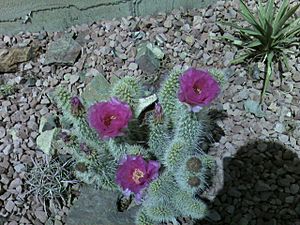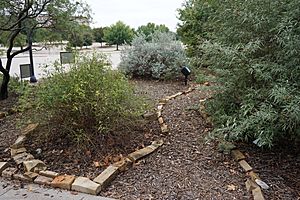Xeriscaping facts for kids
Xeriscaping is a special way of landscaping and gardening. It helps reduce or even remove the need for extra water from irrigation. This method is very popular in places that don't have a lot of fresh water. It's also becoming more common as water for watering plants becomes harder to get. Xeriscaping can be a great choice instead of traditional gardening.
Sometimes, people use other names for xeriscaping. These include water-saving landscapes, drought-friendly landscaping, or smart scaping. This type of gardening focuses on using plants that naturally fit the local weather. It also tries to stop water from being lost through evaporation or running off. The exact plants used depend on the climate. Xeriscaping is different from natural landscaping because its main goal is to save water, not just to use native plants.
Some people used to think xeriscaping meant ugly gardens with just cacti and rocks. But studies show that when people learn about saving water in gardens, they start to like xeriscaping much more.
Contents
What Does Xeriscape Mean?
The word xeriscape was created in 1981 by Denver Water. They combined "landscape" with the Greek word xero-, which means "dry". You might sometimes hear "zero-scaping" instead, but this usually means a garden with very few or no plants. Another common misspelling is "xeroscaping".
Why is Xeriscaping a Good Idea?

Xeriscaping has many benefits, especially for the environment and your wallet!
- Save Water: Xeriscapes can use 60% less water than regular lawns. This means more water is available for homes, communities, and nature.
- Less Work: Besides some weeding and adding mulch, xeriscaping needs much less time and effort to take care of.
- Use Rainwater: With good planning, soil, and mulch, xeriscape plants can hold onto rainwater better. This reduces the need for extra watering.
- Lower Costs: Xeriscaping needs fewer fertilizers and less equipment. This is because there's less lawn to care for.
- Reduce Pollution: Lawn clippings add waste to landfills. Fertilizers can also cause urban runoff pollution. Xeriscaping helps reduce both.
- Less Fertilizer: Fertilizers contain chemicals like phosphorus and nitrogen. These can cause harmful algae to grow in water, but xeriscaping helps avoid this.
How to Create a Xeriscape Garden

Denver Water first came up with seven key ideas for xeriscaping. These ideas are simple and can help anyone create a garden that uses less water. They work in many different places and are easy for homeowners to follow.
1. Plan Your Garden
Start by drawing a map of your yard. Include your house, driveway, paths, and any existing trees. Then, decide where you want different areas, like grassy spots or flower beds. Finally, plan where each type of plant will go.

2. Improve Your Soil
Most plants grow better with compost mixed into the soil. Compost helps the soil hold water. However, some desert plants prefer rocky soil. Make sure your plants fit your soil, or change the soil to fit your plants.
3. Water Smartly
You can water your xeriscape by hand or with an automatic system. Water grass areas separately from other plants. Use watering methods that are best for each type of plant. For grass, use sprinklers that make large drops and stay low to the ground. For trees, shrubs, and flowers, drip lines or bubblers are very efficient.
If you water by hand, avoid sprinklers that spray water high in the air. Water deeply but not too often to help plants grow strong roots. To save water, never water during the day. If you have an automatic system, adjust it monthly for the weather. Also, add a rain sensor so it turns off when it rains.
4. Pick the Right Plants
Different parts of your yard get different amounts of sunlight, wind, and moisture. Group plants that need similar light and water together. Place them in areas that match their needs. For example, put plants that need moderate water in shady spots or near downspouts. Grass usually needs the most water, while shrubs and flowers need about half as much.
Dry, sunny areas are perfect for low-water plants that thrive in your climate. Using a mix of plants with different heights, colors, and textures makes your garden interesting and beautiful.
5. Use Mulch
Mulch helps keep plant roots cool and stops the soil from getting hard. It also reduces water loss from evaporation and stops weeds from growing. Organic mulches, like bark chips, should be 2 to 4 inches deep. Inorganic mulches, like rocks, should be 2 to 3 inches deep. Be careful with too many rocks, as they can make the area hotter.
6. Limit Lawn Areas
Traditional turf grass lawns use a lot of water. Native grasses, like buffalo grass and blue grama, need much less water. These grasses are greenest in summer. Some new types of bluegrass and tall fescue can also save a lot of water. Fine fescues are great for shady areas or places with low foot traffic.
By choosing the right grass and only having lawns where you really need them, you can save a lot of water and maintenance time.
7. Keep it Maintained
All gardens need some care. Lawns need to be aerated in spring and fall, and fertilized every 6 to 8 weeks. Cut grass to about 3 inches high and let the clippings stay. Trees, shrubs, and flowers need occasional pruning to remove dead parts or control their size. You can even shred removed plant material to use in your compost pile!
The Role of Lawns
Many people love their turf grass lawns. Lawns became popular in England and are often seen as a sign of a nice home. In the United States, lawns cover a huge area, making them the most watered "crop." Even though lawns need a lot of water, fertilizer, and care, they are very common in cities and suburban areas. Often, these lawns are not even used for playing or other activities.
Xeriscaping offers a different way to design gardens without using so much lawn. It doesn't mean you can't have any grass. Instead, it suggests having smaller lawn areas only where they will actually be used. This helps save water and still creates a beautiful outdoor space.
See also
 In Spanish: Xerojardín para niños
In Spanish: Xerojardín para niños


